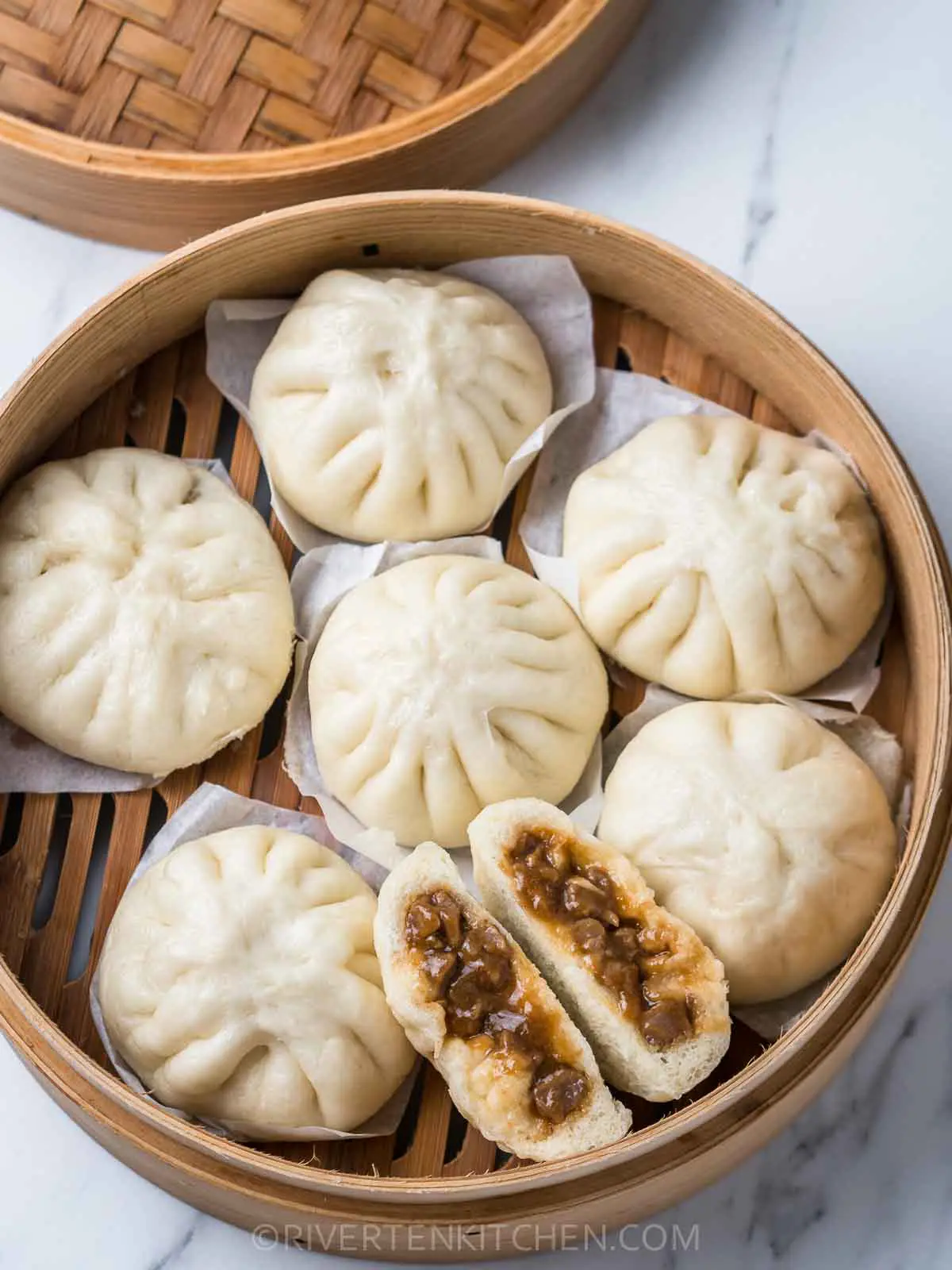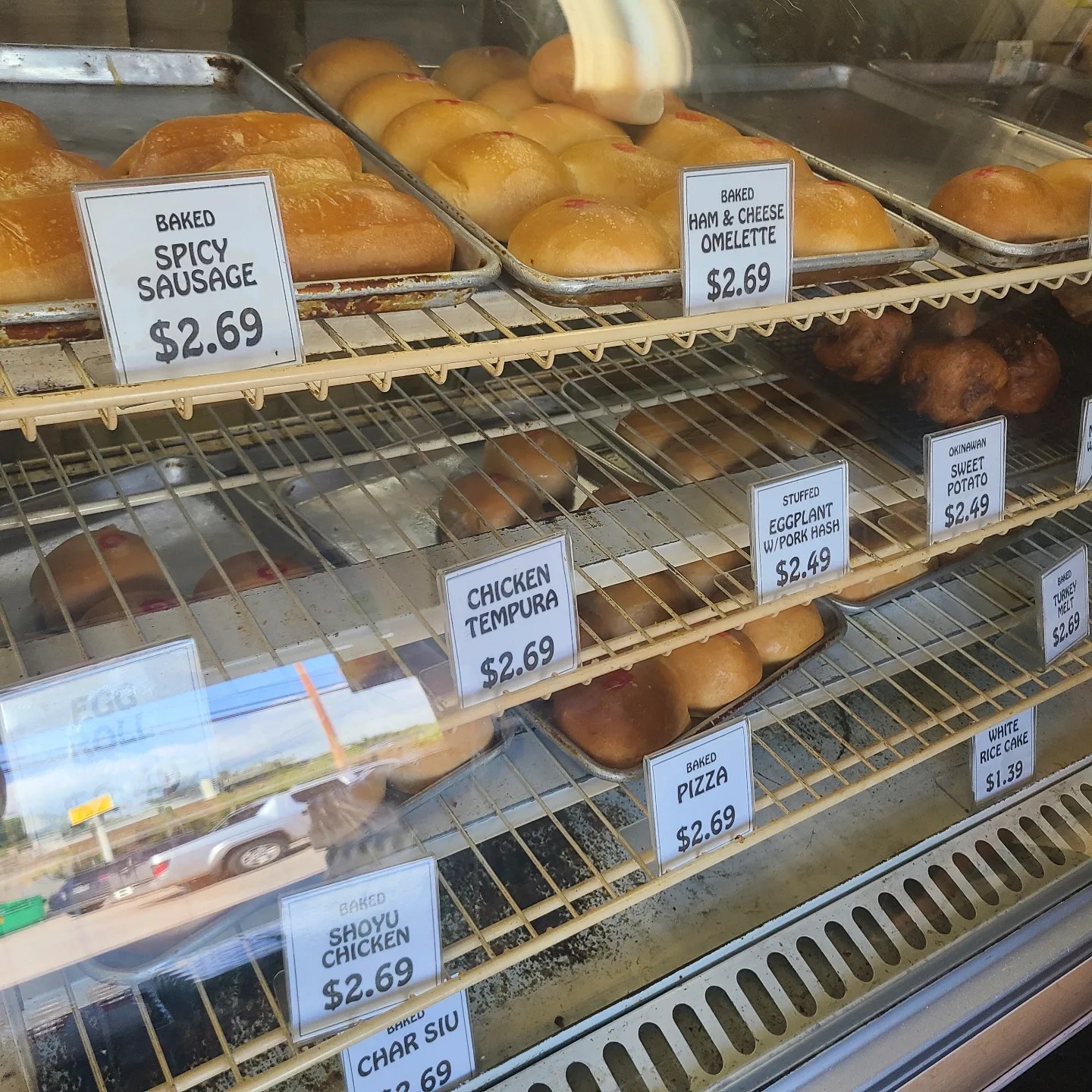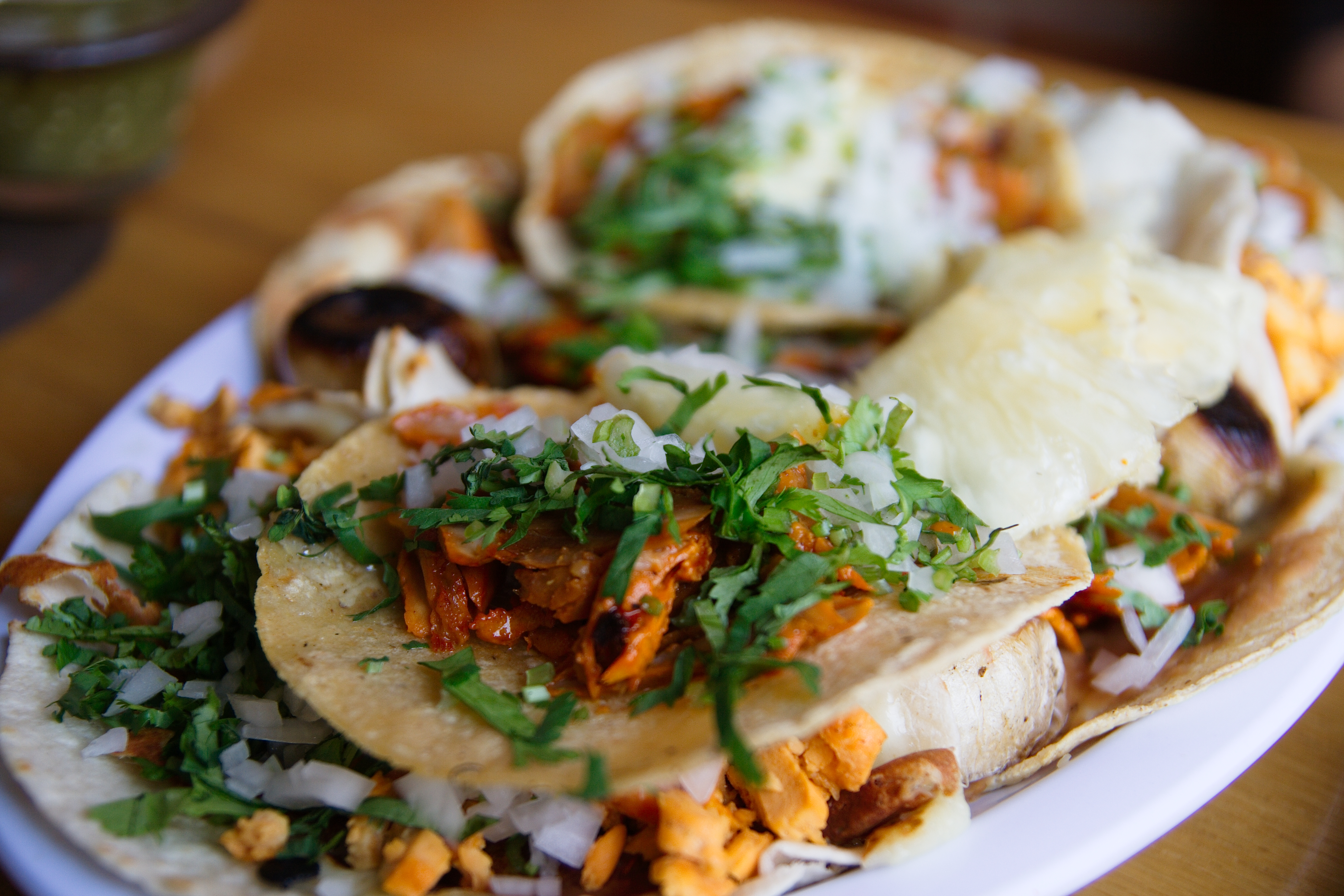|
Baozi
Baozi (), or simply bao, is a type of yeast-leavened filled bun in various Chinese cuisines. There are many variations in fillings (meat or vegetarian) and preparations, though the buns are most often steaming, steamed. They are a variation of ''mantou'' from Northeastern Chinese cuisine, Northern China. Baozi are popular throughout China and have even made their way into the cuisines of many other countries through the Overseas Chinese, Chinese diaspora. History and etymology Written records from the Song dynasty show the term baozi in use for filled buns. Prior to the Northern Song dynasty (960–1279), the word ''mantou'' was used for both filled and unfilled buns. According to legend, the filled baozi is a variation of manta invented by military strategist Zhuge Liang. Over time ''mantou'' came to indicate only unfilled buns in Mandarin Chinese, Mandarin and some varieties of Chinese, although the Wu Chinese, Wu Chinese languages continue to use ''mantou'' to refer to both ... [...More Info...] [...Related Items...] OR: [Wikipedia] [Google] [Baidu] [Amazon] |
Siopao
''Siopao'' (), is a Philippine steamed bun with various fillings. It is the indigenized version of the Fujianese ''baozi'', introduced to the Philippines by Hokkien immigrants during the Spanish colonial period. It is a popular snack in the Philippines and is commonly sold by bakeries and restaurants. Description Siopao is derived from the baozi, introduced by Hokkien Chinese immigrants to the Philippines during the Spanish colonial period. The name is derived from Philippine Hokkien ''sio-pau'' (). Historically, the most popular siopao buns in Manila were the ones made by restaurateur Ma Mon Luk at the turn of the 20th century. Siopao differs from the baozi in that it is much larger and is eaten held in the hands like a sandwich. It also uses different traditional fillings. The most common fillings are pork '' asado'' (indigenized braised version of the Cantonese '' char siu'') and '' bola-bola'' (literally "meatball", a combination of pork, chicken, beef, shrimp or s ... [...More Info...] [...Related Items...] OR: [Wikipedia] [Google] [Baidu] [Amazon] |
Chinese Cuisines
Chinese cuisine comprises cuisines originating from China, as well as from Chinese people from other parts of the world. Because of the Chinese diaspora and the historical power of the country, Chinese cuisine has profoundly influenced many other cuisines in Asia and beyond, with modifications made to cater to local palates. Chinese food staples such as rice, soy sauce, noodles, tea, chili oil, and tofu, and utensils such as chopsticks and the wok, can now be found worldwide. The world's earliest eating establishments recognizable as restaurants in the modern sense first emerged in Song dynasty China during the 11th and 12th centuries. Street food became an integral aspect of Chinese food culture during the Tang dynasty, and the street food culture of much of Southeast Asia was established by workers imported from China during the late 19th century. The preferences for seasoning and cooking techniques in Chinese provinces depend on differences in social class, religion, his ... [...More Info...] [...Related Items...] OR: [Wikipedia] [Google] [Baidu] [Amazon] |
Xiaolongbao
''Xiaolongbao'' (小籠包 , 'little basket bun') is a type of Chinese tangbao (), traditionally prepared in a ''xiaolong'', a small bamboo steaming basket. The xiaolongbao originates from the city of Changzhou in Jiangsu province, and is an iconic dish of Jiangnan cuisine. Different cities across the Jiangnan region have varying styles of xiaolongbao. Outside of China, the Nanxiang xiaolongbao associated with Shanghai is the most well known. In the Shanghainese language, they are known as or ''xiaolong mantou'', as Wu Chinese-speaking peoples use the traditional definition of ''mantou'', which refers to both filled and unfilled buns. The Suzhou and Wuxi styles are larger (sometimes twice as large as a Nanxiang xiaolongbao) and have sweeter fillings. The Nanjing style is smaller with an almost translucent skin and less meat. In English, the xiaolongbao are often referred to as "soup dumplings", but "soup dumpling" in Chinese may translate to the broader culinary cate ... [...More Info...] [...Related Items...] OR: [Wikipedia] [Google] [Baidu] [Amazon] |
Mantou
''Mantou'' ( zh, t=饅頭, s=馒头, first=t), often referred to as a Chinese steamed bun, is a white and soft type of steamed bread or bun popular in northern China. Folk etymology connects the name ''mantou'' to a tale about Zhuge Liang. Description ''Mantou'' are typically eaten as a staple food in northern parts of China where wheat, rather than rice, is grown. They are made with milled wheat flour, water and leavening agents. In size and texture, they range from , soft and fluffy in the most elegant restaurants, to over , firm and dense for the working man's lunch. As white flour, being more heavily processed, was once more expensive, white ''mantou'' were something of a luxury in preindustrial China. Traditionally, ''mantou'', ''bing'', and wheat noodles were the staple carbohydrates of the northern Chinese diet, analogous to rice, which forms the mainstay of the southern Chinese diet. They are also known in the south but are often served as street food or in re ... [...More Info...] [...Related Items...] OR: [Wikipedia] [Google] [Baidu] [Amazon] |
Tangbao
''Tangbao'' or soup buns are large, soup-filled steamed buns (''baozi'') in Chinese cuisine. They are also sometimes known as ''guantang bao'' or soup-filled buns. Various varieties are found, with some name variations in various parts of the country. All of these buns are made by wrapping a gelatinous filling in dough, which is then steamed to melt the filling into soup. ''Tangbao'' first appeared in the capital city of the Song dynasty, Bianjing, now Kaifeng, Henan. It spread to the Yangtze River delta following the Jingkang Incident. Types Some examples of tangbao include: * ''Tangbao'' from Kaifeng, in Henan province: The traditional ''tang bao'' in Kaifeng is a large bun, similar to other baozi, which is bitten open to release the soup filling, which is then drunk with a spoon. However, the traditional form has all but disappeared, with most eateries choosing to serve a Jiangsu-style ''tangbao'' where the soup is drunk with a straw. * ''Tangbao'' from Yangzhou, Jingj ... [...More Info...] [...Related Items...] OR: [Wikipedia] [Google] [Baidu] [Amazon] |
Manapua
''Manapua'' is the Hawaiian cuisine, Hawaiian adaptation of the Chinese bun, ''baozi'', derived specifically from ''char siu bao''. However, in contemporary times, the term is generally applied to a large ''char siu bao'' or other steamed, baked, or fried ''bao'' variations of different fillings. These ''bao'' would later be known as ''manapua'', said to be a portmanteau of the Hawaiian language, Hawaiian phrase ''mea ono puaa'', roughly translated as "pork cake" - ''mea ono'' referring to any food item encompassing dessert, cake, pastry, cookie and ''puaa'' meaning "pork" or "pig". Background The prospect of financial reward found in the Sugar plantations in Hawaii, sugar industry caused much Chinese immigration to Hawaii, Chinese immigration starting in the mid 1800s. The Chinese would bring along with them their foods including ''baozi'', a carbohydrate rich food essential for sustenance against the intense physical labor demanded in sugar production. Some of these Chinese labo ... [...More Info...] [...Related Items...] OR: [Wikipedia] [Google] [Baidu] [Amazon] |
Steaming
Steaming is a method of cooking using steam. This is often done with a food steamer, a kitchen appliance made specifically to cook food with steam, but food can also be steamed in a wok. In the American Southwest, steam pits used for cooking have been found dating back about 5,000 years. Steaming is considered a healthy cooking technique that can be used for many kinds of foods. Compared to full immersion in boiling water, steaming can be faster and more energy-efficient because it requires less water and takes advantage of the excellent thermodynamic heat transfer properties of steam. History Some of the world's earliest examples of steam cooking were found in China's Yellow River Valley; early steam cookers made of stoneware have been found dating back as far as 5,000 BCE. And also in Gunma Prefecture, Japan, created during the Stone Age. Some of the earliest examples of steam cooking have been found in Italy and Sardinia, created during the Bronze Age, and in Cochise Cou ... [...More Info...] [...Related Items...] OR: [Wikipedia] [Google] [Baidu] [Amazon] |
Goubuli
Goubuli, also sometimes transcribed as Go Believe (), is a brand of stuffed baozi from Tianjin, China. Founded in 1858, it is one of China's longest established brands. Each Goubuli bun has eighteen wrinkles. Etymology There are many explanations for the name Goubuli. The oft-quoted one relates to a poor village boy nicknamed Gouzhai. At 14, he became an apprentice at a food store. Thereafter, he set up his own shop specialising in selling steamed, stuffed baozi. His supposedly very delicious baozi soon gained immense popularity in a short period of time. As a result, Gouzhai became too preoccupied with his business to converse with his customers; so they started to complain, "Gouzhai does not talk to people" (which loosely translates as ). In another similar story, there was a boy named Gao Guiyou who had a terrible attitude and could ignore people for days if he was angered. Thus, he was named by his mother Goubuli (his nickname "Gou" with "Buli" meaning "ignores"). At 14, ... [...More Info...] [...Related Items...] OR: [Wikipedia] [Google] [Baidu] [Amazon] |
Meigan Cai
Meigan cai, also called mei cai, is a type of dry pickled Chinese mustard of the Hakka people from Huizhou, Guangdong province, China. Meigan cai is also used in the cuisine of Shaoxing (), Zhejiang province, China. The pickle consists of a whole head of various varieties of 芥菜 ( Chinese mustard), 油菜 (rape), and 白菜 ( Chinese cabbage) that has undergone an elaborate process consisting of drying, steaming, and salting. The vegetables are harvested, trimmed before the Qingming Festival, and sun-dried until limp. It is then salted or brined, kneaded until the juices are exuded, and left to ferment in large clay urns for 15 to 20 days. The vegetable is then repeatedly steamed and dried until reddish brown in colour and highly fragrant. Uses Culinary This pickled vegetable is used to flavor stews, in particular, ''meigan cai cooked with pork'' (梅菜扣肉), a classic dish from Hakka cuisine. In this dish, slices of pork belly are parboiled and then deep-fried before bei ... [...More Info...] [...Related Items...] OR: [Wikipedia] [Google] [Baidu] [Amazon] |
Taco
A taco (, , ) is a traditional Mexican cuisine, Mexican dish consisting of a small hand-sized corn tortilla, corn- or Flour tortilla, wheat-based tortilla topped with a Stuffing, filling. The tortilla is then folded around the filling and finger food, eaten by hand. A taco can be made with a variety of fillings, including beef, pork, chicken, seafood, beans, vegetables, and cheese, and garnished with various condiments, such as salsa (sauce), salsa, guacamole, or sour cream, and vegetables, such as lettuce, coriander, onion, tomatoes, and Chili pepper, chiles. Tacos are a common form of antojitos, or Mexican street food, which have spread around the world. Tacos can be contrasted with similar foods such as burritos, which are often much larger and rolled rather than folded; taquitos, which are rolled and fried; or chalupas/Tostada (tortilla), tostadas, in which the tortilla is fried before filling. Etymology The origins of the taco are not precisely known, and etymologies for ... [...More Info...] [...Related Items...] OR: [Wikipedia] [Google] [Baidu] [Amazon] |
Yangzhou
Yangzhou is a prefecture-level city in central Jiangsu Province, East China. Sitting on the north bank of the Yangtze, it borders the provincial capital Nanjing to the southwest, Huai'an to the north, Yancheng to the northeast, Taizhou, Jiangsu, Taizhou to the east, and Zhenjiang across the river to the south. Its population was 4,559,797 at the 2020 Chinese census, 2020 census and its urban area is home to 2,635,435 inhabitants, including three urban districts, currently in the agglomeration. Historically, Yangzhou was one of the wealthiest cities in China, known at various periods for its great merchant families, poets, artists, and scholars. Its name (lit. "Rising Prefecture") refers to its former position as the capital of the ancient Yangzhou (ancient China), Yangzhou prefecture in Administration of territory in dynastic China, imperial China. Yangzhou was one of the first cities to benefit from one of the earliest World Bank loans in China, used to construct Yangzhou therma ... [...More Info...] [...Related Items...] OR: [Wikipedia] [Google] [Baidu] [Amazon] |
Varieties Of Chinese
There are hundreds of local Chinese language varieties forming a branch of the Sino-Tibetan languages, Sino-Tibetan language family, many of which are not Mutual intelligibility, mutually intelligible. Variation is particularly strong in the more mountainous southeast part of mainland China. The varieties are typically classified into several groups: Mandarin Chinese, Mandarin, Wu Chinese, Wu, Min Chinese, Min, Xiang Chinese, Xiang, Gan Chinese, Gan, Jin Chinese, Jin, Hakka Chinese, Hakka and Yue Chinese, Yue, though some varieties remain unclassified. These groups are neither clades nor individual languages defined by mutual intelligibility, but reflect common phonological developments from Middle Chinese. Chinese varieties have the greatest differences in their phonology, and to a lesser extent in vocabulary and syntax. Southern varieties tend to have fewer initial consonants than northern and central varieties, but more often preserve the Middle Chinese final consonants. All ... [...More Info...] [...Related Items...] OR: [Wikipedia] [Google] [Baidu] [Amazon] |









